At 20:30 on Tuesday 18th April 2017, the AEMO issued Market Notice 58400 noting that Administered Pricing had been declared for market ancillary services in South Australia, beginning 20:35 – as shown here via NEM-Watch:
We’ve fielded some calls about this pricing event and have prepared some of the following images below to answer direct questions – however we thought it would be of broader interest to our WattClarity readership, so have included here, as well.
My apologies, in advance, for any errors or omissions in the following – I’ve run over my budgeted time already so have to post this as-is… (I’m sure some of our more learned readers will be happy to point out these mistakes in comments below).
In the first image, I’ve wound NEM-watch back (in the “playback” function we first introduced in 2003) to show what the market conditions were for the 11:25 dispatch interval on Tuesday 18th April (so towards the end of the 11:30 Trading Period). For a start, we show the Energy Layer (the one most people focus on, 99% of the time):
As noted on the image, AEMO issued a Market Notice just prior to alert the market to a change in the underlying transmission network, that resulted in new Constraint Sets being invoked (as us if you want to know more about this) – which led to a significant reduction in the transfer capability on the Heywood link. Here’s the full text of that Market Notice:
As highlighted at the time, the Heywood link was effectively “hard-wired” such that it had to flow west. Because of the price difference (i.e. buying expensive in VIC to sell cheaper in SA) the flow was dispatched to be as low as it could be.
We then flip NEM-watch (still re-wound to 11:25 on Tuesday) to show the Raise Regulation FCAS Service (i.e. the one FCAS service, of 8 in total, where Administered Prices were declared), and we see a few other pieces of information:
For a start, we can see the Raise Reg Price for the 11:25 dispatch interval spike up to $14,000/MWh (i.e. the Market Price Cap that applies to each FCAS commodity, as well as to Energy), where it remained for many hours.
Powering up NEM-Review and panning back over the past 4 days, we see the summary of Energy and Raise/Lower FCAS prices in South Australia against a backdrop of aggregate local generation:
Finally, for those who really want to understand more, I’ve powered up ez2view and Time-Travelled back to 11:25 to look at the specifics of generator bids for Raise Regulation FCAS (narrowed down to just generators in South Australia). This is shown in the following snapshot:
As highlighted on the snapshot:
1) There are precious few generators that offer FCAS in South Australia – for this dispatch interval:
(a) There are a number of thermal plant in South Australia that are not offering FCAS services. Some never do, and are not equipped to do so.
(b) Despite the fact that it is technically a possibility, there are no wind farms in South Australia (or anywhere in the NEM) that offer FCAS Services. Not for this dispatch interval and not, currently, in any dispatch interval (though there is now a trial being organised for Hornsdale to “dip its toe” in the FCAS waters).
(c) There are (yet) no large-scale solar farms in South Australia. I’m not 100% clear on the possibility of solar PV farms providing FCAS – but it’s a moot point until the first one is built.
2) Given the dispatch patterns leading up to the network outage, hence constrained interconnector flow, the only outcome that could supply the necessary local services in South Australia resulted in Pelican Point setting the price with a bid up at the Market Price Cap.
Back in April, guest author Jonathon Dyson noted that “Ancillary Services Matter!” (the explanation in that post will help those who are unfamiliar) . The fact that we’re fielding calls now asking about occurrences in the FCAS market is some evidence that the broader energy sector is becoming aware of this fact.
For those particularly interested in FCAS, and perhaps relatively new to the topic, then other posts by Kate Summers and Harley MacKenzie will also be of some educational value.
Interesting times…


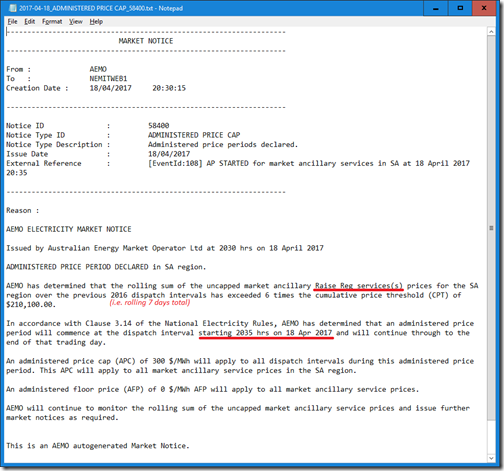
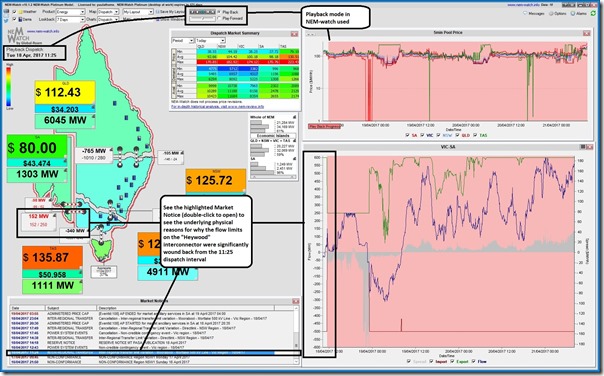
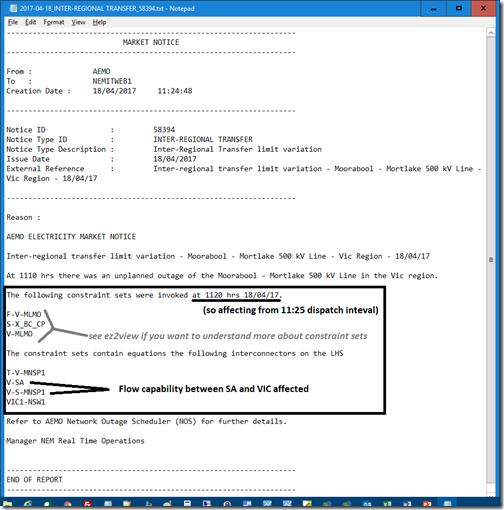
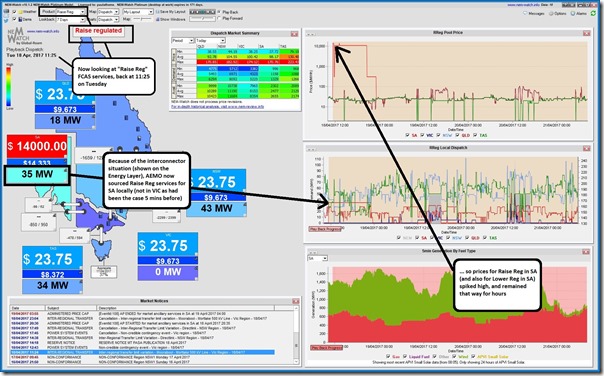
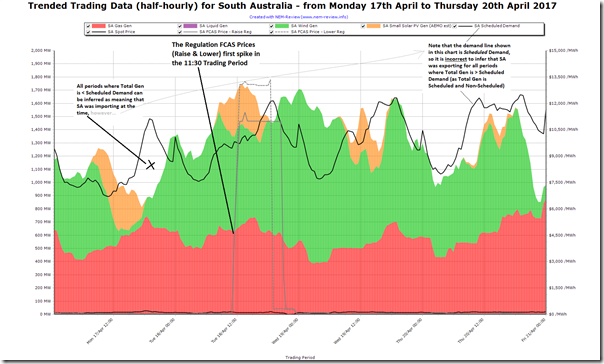
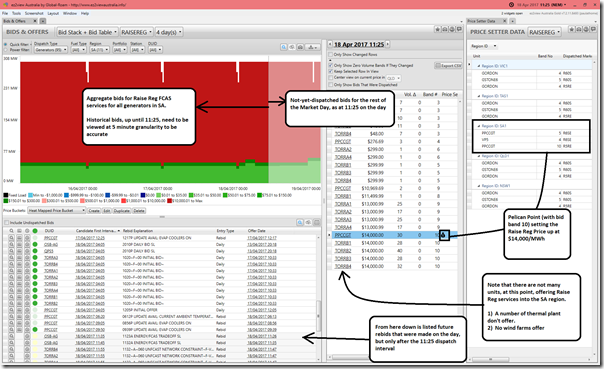
Thanks for writing this up Paul – an interesting situation.
There are a number of things going on here that are worth pointing out.
The transmission line which went out of service, causing the sequence of events, runs between Mortlake Power Station in western Victoria and the main part of the Vic 500kV grid. It is one of two lines that supply the Portland smelter and also the interconnection with South Australia. So with this line out, a trip of the second 500kV line on this corridor (the Moorabool – Tarrone line) would isolate South Australia + generation and load in the south west of Victoria (principally Mortlake PS and the smelter) from the rest of the NEM.
In this situation AEMO invokes a couple of key constraints (amongst others):
1) FCAS constraints requiring 35 MW of FCAS regulation services (“regulation raise” and “regulation lower”) to be sourced from South Australian generation – so that if the second line trips, there will be some generators already providing regulation services in SA to help manage frequency in the “islanded” South Australian system (actually SA + SW Vic in this case). While the DC Murraylink interconnector would still connect the two regions, it cannot currently transfer regulation services due to its design – presumably this might be another technical option for provision of FCAS in SA along with the possibilities you mention of wind or solar generation being modified to provide some of these services. Whether feasible or economic I don’t know.
As you point out the very limited FCAS bidstack for these services in SA plus the requirement to source this locally under the above constraint led to pricing of these raise and lower regulation services shooting upwards. There is clearly insufficient competition for provision of these services within SA to drive prices down to reasonable levels when they are required locally under conditions like those that existed last Tuesday. (Ironically, technically Mortlake PS could provide regulation FCAS within the SA + SW Vic island, and had relatively cheap bids in for these services, but the way the NEM’s regional boundaries are defined, it is obviously not considered a South Australian generator for the purposes of procuring “local” FCAS when this constraint operates! – I wonder if AEMO could make the relevant constraint a little bit smarter so that under the appropriate precontingent conditions Mortlake could be included in the generators from which “local” FCAS is procured – but possibly not, due to the way that regional pricing and cost recovery for FCAS operate.)
2) The risk of islanding also leads to a constraint being imposed on net exports from the SA + SW Vic region, so that if the second line trips there won’t suddenly be such an excess of generation in the island to cause a frequency rise too large to be handled. The limit is 50 MW but because the island would include Mortlake generation and the Portland smelter, the constraint doesn’t simply go onto the SA-Vic (Heywood) interconnector, but includes Mortlake generation and Portland load as well.
At the time of this constraint being invoked, Mortlake was running at 551MW, very close to full capacity and well above Portland smelter load (which appears to have been about 220 MW), so the constraint forced NEMDE to dispatch additional flows westwards on the Heywood interconnector, at the same time ramping down Mortlake generation as fast as possible (nominally 26MW per minute across the two units or 130 MW per 5 minute dispatch interval), in an attempt to keep the net flow to the rest of Victoria from the SW Vic region to under 50 MW. This had the effect of forcing generation levels and dispatch price downwards in SA due to the increased Heywood imports, and briefly upwards in the rest of the NEM (probably due to the rapid ramping down of Mortlake). Hence the “counterprice” inter-regional flow mentioned in your writeup.
Interestingly, within a few dispatch intervals and as Mortlake continued to ramp down to about 300 MW, SA reached the position of being a net exporter to Vic (with Murraylink flows eastwards exceeding westward Heywood flows) so prices in SA being lower than those in Vic were in the expected relationship.